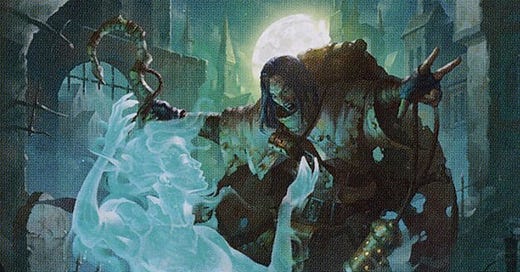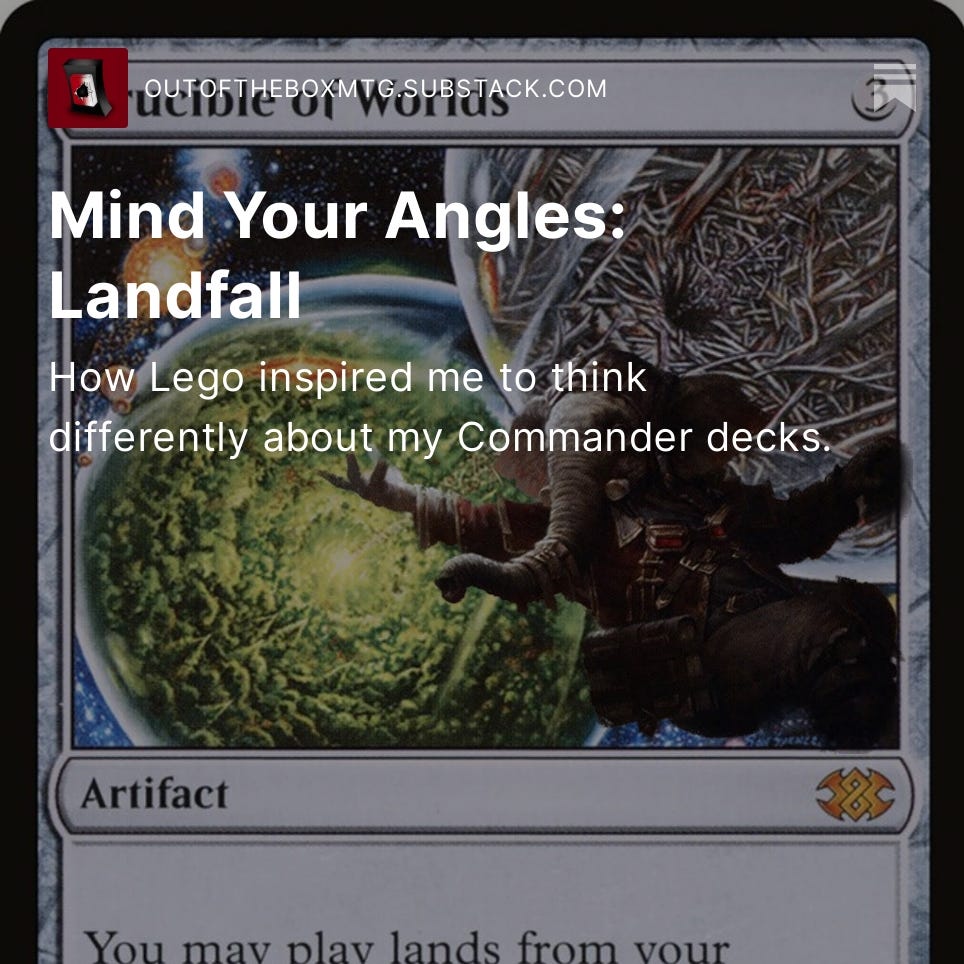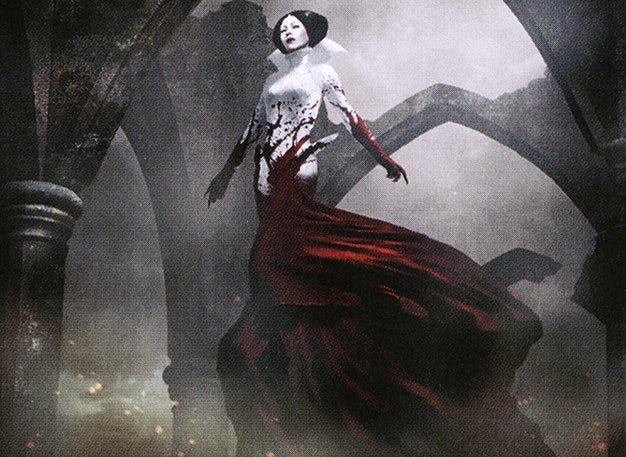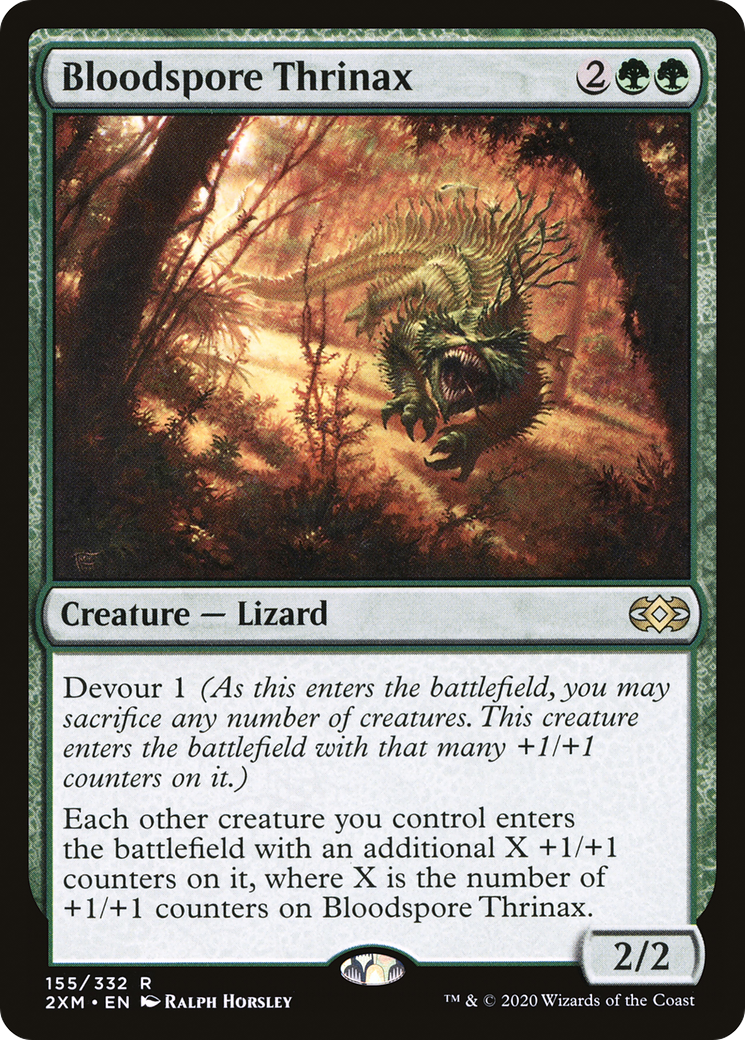Mind Your Angles: Selesnya Aristocrats
Does an aristocrats deck always have to include black, or can we build a powerful sacrifice deck without the color of death and decay in MTG?
All it Takes is a Little Sacrifice
Welcome back to the second installment of Mind Your Angles, a commander deckbuilding series inspired by the endless creativity of Lego and its ability to take square blocks and transform them into all sorts of different shapes! Mind Your Angles takes that idea and asks, “How can we transform “square” Magic cards into equally exciting new and unique shapes?”, or more simply put, “How can we take classic and established archetypes and do something new and inventive with them?” In our first installment, we built a Boros landfall deck headed by Quintorius, Field Historian, leveraging bringing lands in and out of the graveyard to make token armies and repeatedly trigger powerful landfall abilities.
If you want to read that one, check it out here: https://open.substack.com/pub/outoftheboxmtg/p/mind-your-angles-landfall?r=2a65a7&utm_campaign=post&utm_medium=post%20viewer
This week I want to tackle one of Commander’s most popular archetypes: aristocrats. A twisted representation of opulence, aristocrats is a creature-based strategy built around throwing out your creatures, as if they are of no importance to you, for value. This often takes the form of dealing damage or life loss to your opponents, making them also sacrifice creatures, generate masses of tokens, etc. In order to know how to get creative and build an effective aristocrats deck outside of the normal color scheme we need to understand the three main things that make aristocrats decks tick:
Death Triggers
Death triggers are the lifeblood of the archetype. Some of the most prolific cards in this category are creatures that cause your opponents to lose life as creatures die, Blood Artist, Zulaport Cutthroat, Cruel Celebrant, and Syr Konrad, the Grim are quintessential examples of “aristocrats”. Outside of cards that cause your opponents to lose life are cards that get additional value from your things dying. Pitiless Plunderer and Mahadi, Emporium Master give your treasures for your things dying. Midnight Reaper and Grim Haruspex draw you cards. Grave Pact and Butcher of Malakir ensure that as you sacrifice your stuff, your opponents also have to sacrifice with you.
Sacrifice Outlets
In order to be able to have your own creatures die reliably aristocrats strategies include a suite of cards that allow you to sacrifice your own creatures at will. Some of these effects are one-time uses that bring with them high value like Village Rites or Plump the Forbidden drawing you cards for the sacrificed creatures. Others stay on board and generate insane amounts of mana, like Pyrexian Altar and Ashnod’s Altar. Others, like Yawgmoth, Thran Physician slowly kill your opponent's creatures or Carrion Feeder grows itself into a massive threat.
Graveyard Recursion
The final piece that makes these decks tick is having ways to bring back all the creatures you have sacrificed along the way to be able to do it all again. This strategy, unlike many others, actively throws away its own resources so in order to stay relevant in the game you need ways to bring back the things that have died. One of the most popular and powerful effects in this category is Living Death, which when played wisely often wipes your opponent's boards and brings all of yours back. Others like Agadeem’s Awakening and Command the Dreadhord can require a lot of mana, but if successful can bring back a game-winning number of creatures.
Knowing now what makes these decks run, we need to look at what colors most often show up in them. To no surprise, an archetype built around death and the graveyard is most heavily represented by black. Almost every major aristocrats card has black in its color identity, but the more interesting piece here is that there are popular commanders in each color pairing of black. White shows up in cards like Teysa Karlov and Elenda the Duck Rose. Red in Garna, Bloodfist of Keld and Judith, the Scourge Diva. Green has a high representation in this strategy with classic commanders such as Meren of Clan Nel Toth and Mazirek, Kraul Death Priest and newcomers like Chatterfang, Squirrel General and Baba Lysaga, Night Witch. Blue has a strong zombie theme in conjunction with the aristocrats and is headed by commanders like Wilhelt, the Rotcleaver or Gisa and Geralf. But overall, black is the color that dominates the world of aristocrats. If we want to get creative and try something new with the archetype, we simply just need to avoid using black in our deck.
Sans-Black Slayers
What options do we have then for synergistic aristocrats/sacrifice commanders without black? Thankfully there are plenty to choose from so preference is going to play a big part in this decision. Mono Blue has Inga, Rune Eyes or Geralf, Visionary Stitcher two very different approaches but are both happy to see their own creatures die. Adding white to the mix, Azoius bring two very cool options in Tobias, Doomed Conquerer and Dennick, Pious Apprentice. Tobias fills a very classic aristocrats role of wanting lots of creatures to die as a way of making more creatures, fueling further the sacrifice engine. Dennick wants creatures to die more methodically and provides artifacts in return that can also be sacrificed for value. Jumping to the opposite side of the color pie, Gruul has a more combo-focused commander in Grumgully, the Generous who can take advantage of persist creatures like Woodfall Primus to infinitely sacrifice and return them to the battlefield with the -1/-1 counter from the Persist trigger being offset by the +1/+1 counter offered by Grumgully. Gruul also has the newly revealed Gimli, Mournful Avenger from the Lord of the Rings set, who turns creature deaths into counters and removal. Staying in Red, Boros has some interesting options. Zabaz, the Glimmerwasp can be used as a pseudo-aristocrat commander using Modular triggers as the main form of death trigger. It also has Koll, the Forgmaster who can use equipment to help reuse creatures after they die. Because death triggers are present in most colors there are plenty of options so get creative with the archetype. For the sake of the article today though I want to focus on one of my favorites, Othelm, Sigaridan Outcast
If you have never seen this card before, you are not alone. Othelm is a Universes Within re-skin of the Stranger Things Secret Lair card Mike, the Dungeon Master. I enjoy the Universes Beyond cards as collector's items, but I love the Magic IP and enjoy the cohesive feel that comes from playing with “in-universe” cards. That being said, I have been very impressed with the Universe Within re-skins of the Secret Lair cards hence why we are building Othelm and not Mike, but if Mike is more your speed, go for it!
You may be asking yourself, “Why are we just playing Othelm? Can’t you add a Friends Forever partner with him?” Yes, yes you can. But are we? No, no we are not. The heart and soul of “Mind your Angles” is about brewing outside the lines, so for the sake of this deck Othelm is going to be a lonely soul. But having played this deck a fair number of times, I promise that it does not need any extra help.
Selesnya, Conclave of Death
Having now established both what makes an aristocrats deck tick as well as the commander we are going to be running let us dive into the various card choices for each of the key categories.
Death Triggers
As we saw with classic black-based aristocrats decks, this section was filled up with cards that cause your opponents to lose life as things die. Unfortunately, those really do not exist in white or green so the death triggers here fill a very different role. This deck has a sub-theme of token creation and +1/+1 counters so most of the best death triggers in the deck revolve around those two functions. One of the best death triggers in this deck is Death’s Presence. It comes at a steep cost, but this card is one of the main engines to get the deck rolling. Pair this card with cards like Boss’s Chauffer, Hangarback Walker, and Hooded Hydra and things can get out of hand fast. As they die move their counters around to each other and you can make a massive army of tokens with ease.
There are also a handful of value death triggers throughout the deck with cards like Ao, the Dawn Sky (a true all-star in the deck) Kura, the Boundless Sky, and Torsten, Founder of Benalia. All of these can come down, be a powerful threat on board, and then provide strong value when they die, especially if you can bring them back again with Othelm’s ability. There are also a number of ramp pieces that synergize with death triggers, the best of which is Rampant Rejuvenator. Pair it with Death’s Presence and it can easily ramp out 6+ lands all onto the battlefield UNTAPPED which can be a game-winner. You also have other more basic death-based ramp cards like Boreas Charger, Primal Druid, and Veridian Emissary that all get a land to the field when they die, but provide added synergy with Othelm allowing you to do that multiple times if sequenced correctly.
Sacrifice Outlets
This is where the deck has the most overlap with more traditional aristocrats decks as a good majority of the best sacrifice outlets are colorless. That being said, there are some unique sac outlets in white and green that also bring a lot of identity to the deck. But starting off with the all-timers, the two main colorless outlets this deck plays are Ashnod’s Altar and Altar of Dementia. You could also play Phyrexian Altar, but I chose to leave it out for budget reasons. The one to not cut though is Altar of Dementia. I have won more games by milling out opponents via this card than not. The play pattern of the deck tends to focus on looping through creatures and moving counters, growing each sacrifice iteration and that can make it almost trivial to mill well over your opponent's collective 300 cards. Especially when paired with my favorite sacrifice outlet in the deck, Bloodpsore Thrinax. This card is an absolute house in the deck. I had a game recently where I had a Bloodspore Thrinax with 256 counters on it, cast a Hangarback Walker for 0 which entered with 256 counters, sacrificed it, and made 256 256 powered thopters. Sacrifice all those to Altar of Dementia and its game over (as if wasn’t already with that many jacked thopters).
Other standouts in the deck are Greater Good and Evolutionary Leap to fuel some card draw, Fanatical Devotion and Marty’s Cause to keep you and your creatures safe, and Perilous Forays for continual ramp. I would also be remiss if I didn’t talk about one of the funniest sacrifice outlets in the deck, Thelonite Monk. It's arguably wrong to play and can easily be replaced by a card like Mondrak, Glory Dominus, but the stories this card brings are hard to pass on. If you have a player at your table with a greedy 5-color mana base this card can single-handedly shut them out of multiple colors by turning their needed lands into forests. There is a fair amount of diversity in the options here and makes the deck feel and play very unique compared to a classic aristocrats build.
Graveyard Recursion
This category is somewhat light in this deck because of Othelm being at the helm. Unlike a traditional aristocrats deck where you want to be recurring creatures in a big batch to sacrifice over again, the deck wants to be bringing single creatures back over and over again so the “recursion” package in the deck looks a bit different. Recursion in this deck is all about being able to activate Othelm multiple times in a turn cycle so cards like Seedborn Muse, Drumbellower, and Patriar’s Seal are the all-stars in this category. Another one-time recursion engine is Luminous Broodmoth which when paired with Othelm can allow you to get up to 4 death triggers out of a single creature. If you have a Torsten on the battlefield for example, you can sacrifice it, bring it back with a flying counter, sacrifice it again and activate Othelm bringing it back for a second time, sacrifice it again, return it with a new flying counter, and then sacrifice it for a fourth and final time, leaving you with a grip full of cards and 28 soldier tokens.
The deck also does run one mass reanimation spell in Ascend from Avernus which is a powerful way to return your entire graveyard to the battlefield for more sacrifice shenanigans.
There are also a few hidden combos in the deck that can provide a nice way to close out a game when needed, made up of pieces that synergize well with the deck already so they are kinda free to have in the deck (if I’m being honest I didn’t even realize these were in the deck when I first built it, I stumbled upon both of them on accident while playing). One with the Kami + Bloodspore Thrinax + a sacrifice outlet can give you infinite creatures, infinite ETB and LTB triggers, and depending on the sacrifice outlet infinite mana or mill. The same result can be achieved with Basri’s Lieutenant + Odric’s Outrider + a sacrifice outlet. The deck can easily function without these combos, I’d recommend cutting One with the Kami and Odric’s Outrider if you want to go combo-less and replace them with other cool sacrifice or untap synergies to keep the deck churning through its creatures!
You can find the full decklist linked here: https://www.moxfield.com/decks/KyzBpFTa4kaDsT_BC1Y3bQ
Thanks for joining for another edition of “Mind Your Angles”. Hopefully, this inspired you to take another look at aristocrats and see if there is a new and inventive way to build that archetype! What other commanders do you think could make a fun non-black aristocrats deck? Or maybe it inspired you to look at another one of your decks and ask yourself how you can make the deck more unique. That is what this series is all about. It’s all about turning the traditional into the unique. The classic into the statement. The simple Lego brick into a work of art. See you next time on “Mind Your Angles” where we will take another classic archetype and turn it on its head!








